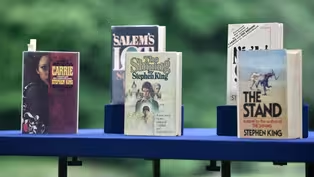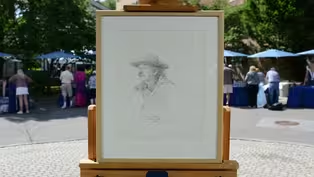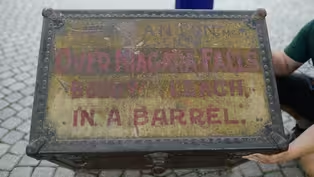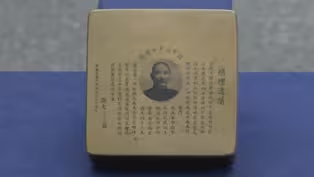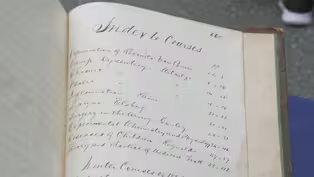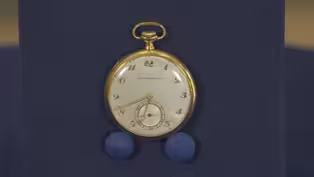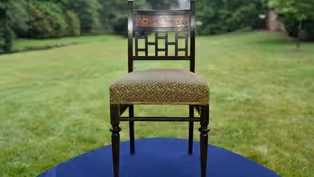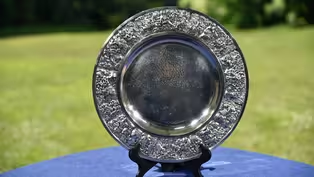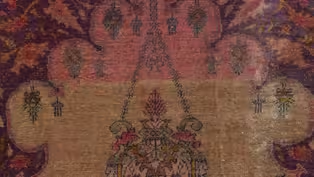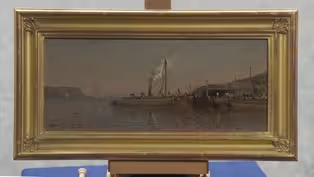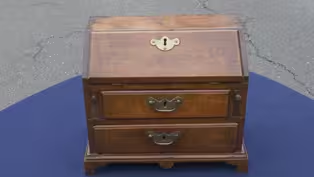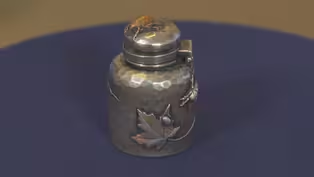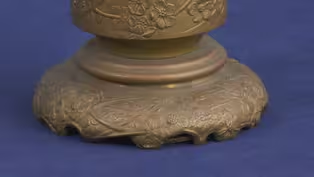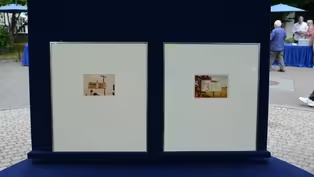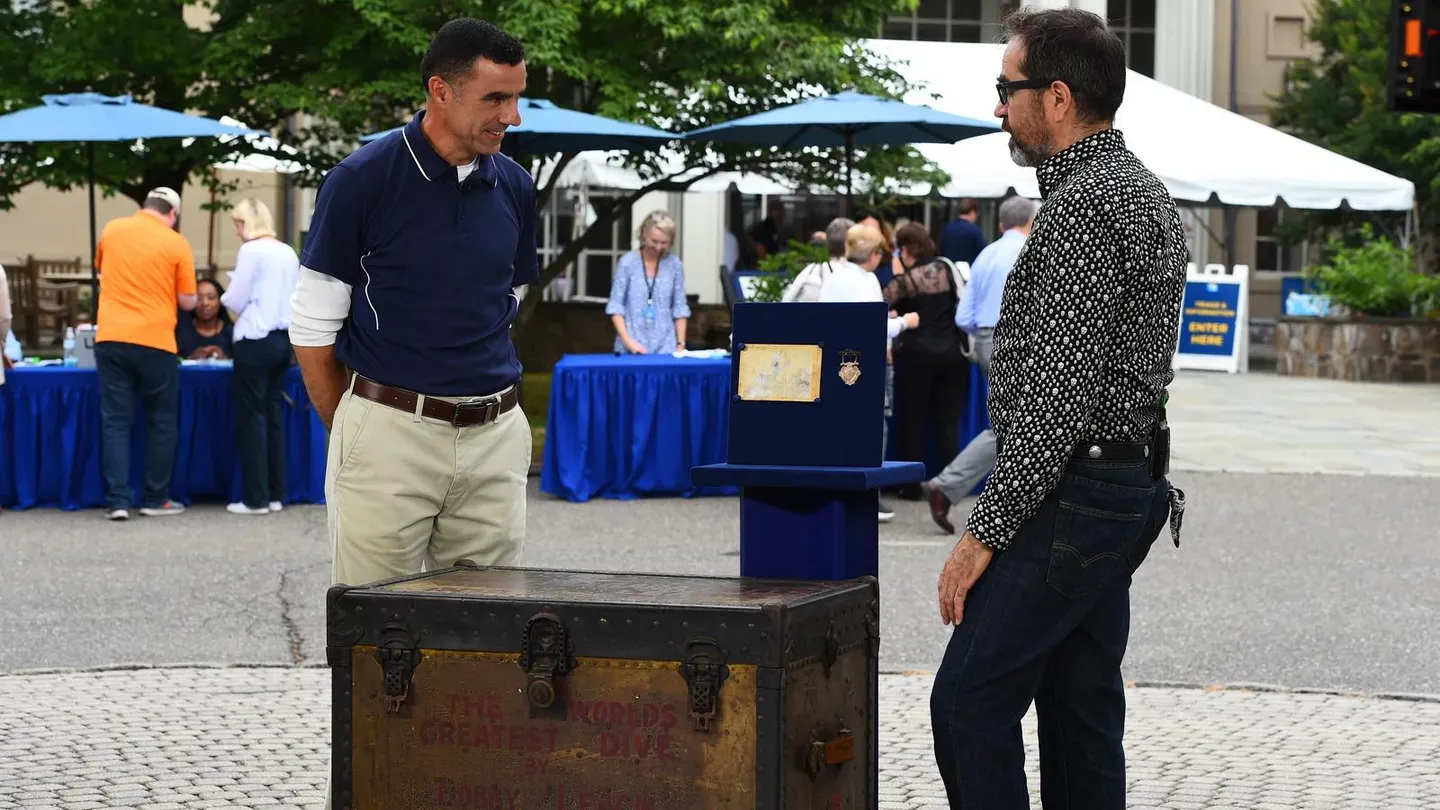

Winterthur Museum, Gardens & Library, Hour 2
Season 24 Episode 2 | 52m 29sVideo has Closed Captions
Discover Delaware treasures appraised at Winterthur including one valued at $100K-$150K!
Discover Delaware treasures appraised at Winterthur Museum, Garden & Library, such as Stephen King first editions from 1974-1977, an Ilya Schor silver plate, and a Louis Comfort Tiffany oil, ca. 1870. Which is valued at $100,000-$150,000?
Problems playing video? | Closed Captioning Feedback
Problems playing video? | Closed Captioning Feedback
Funding for ANTIQUES ROADSHOW is provided by Ancestry and American Cruise Lines. Additional funding is provided by public television viewers.

Winterthur Museum, Gardens & Library, Hour 2
Season 24 Episode 2 | 52m 29sVideo has Closed Captions
Discover Delaware treasures appraised at Winterthur Museum, Garden & Library, such as Stephen King first editions from 1974-1977, an Ilya Schor silver plate, and a Louis Comfort Tiffany oil, ca. 1870. Which is valued at $100,000-$150,000?
Problems playing video? | Closed Captioning Feedback
How to Watch Antiques Roadshow
Antiques Roadshow is available to stream on pbs.org and the free PBS App, available on iPhone, Apple TV, Android TV, Android smartphones, Amazon Fire TV, Amazon Fire Tablet, Roku, Samsung Smart TV, and Vizio.
Buy Now

ANTIQUES ROADSHOW 2025 Tour!
Enter now for a chance to win free tickets to ANTIQUES ROADSHOW's 2025 Tour! Plus, see which cities we're headed to!Providing Support for PBS.org
Learn Moreabout PBS online sponsorship♪ ♪ CORAL PEÑA: "Antiques Roadshow" is teeming with treasures at the Winterthur Museum, Garden, and Library in Delaware.
As soon as you came in with this, my heart started to beat a little faster.
Oh, my goodness.
What?
For real?
♪ ♪ PEÑA: Winterthur Museum, Library, and Garden is the legacy of a man considered to be the greatest collector of his generation.
Henry Francis du Pont's two passions, botany and antiques, found their ultimate expression here at Winterthur, with the magnificent gardens and an incredible collection of Americana, art, and artifacts.
"Roadshow" is finding the natural and human-made treasures of Winterthur to be quite inspirational.
What items were our guests inspired to bring today?
Take a look.
♪ ♪ (people talking in background) WOMAN: My collection got so big, I didn't know where to put it.
So, my sister gave me this Santa Claus, and this is how it started.
Many people have given me pins, and I have also bought a lot in antique shops.
I've gone all over to collect them.
It's kind of like an obsession for me.
I love it.
Do you break him out at Christmas, or is he out year-round?
He's out year-round.
(laughing): So, roughly, how many pins are on Santa right now?
There might be 500.
If you have 500 pins, and they averaged out ten dollars a pin, that's $5,000.
Right.
Easy!
I have maybe 50 more pins at home, so...
Anybody out there have a Mrs. Claus?
We need one.
(laughs) So, tell me, who is this handsome devil?
Oh, that's me.
I see there's a little bit of stubble on the chin.
The beard's come on nicely.
Yeah, I've always had the beard far back.
Well, started growing it right after that.
Tell me, what's the inscription say there now?
"For Andy Bell, from his friend Andy Wyeth."
Andrew Wyeth.
So we have an Andrew Wyeth here.
Mm-hmm.
And of course, here we are in the Brandywine Valley.
And before we got here, I was chatting with my colleagues, and who, who would we want to see most?
One of the Wyeth family's.
Oh, for sure.
Because this is their backyard.
They were from Chadds Ford, weren't they?
Mm-hmm.
But you have a connection with them in some way, is that correct?
Well, I've known them since I was about 13 years old.
Right.
My mom had a restaurant in Chadds Ford, and he and Betsy, they used to stop in the restaurant.
And then my father had an electric motor shop there.
Anyway, we just hooked up a friendship.
I've always known Andy, we used to snowmobile together.
I took care of his cars, and we'd just become good friends.
And he did this drawing of you.
When, when was this done?
He did that in '92.
He was working on a painting, there was another boy posing for it.
And he just did it without us, and he called the painting "Bonfire."
He did several of them that day.
He did that up in N.C.'s studio.
It's done in pencil, which is a medium that he favored.
Mm-hmm.
In the drawing, there's one or two little crease marks.
Can you elaborate on how they came about?
Well, on almost all of his drawings, you'll see them little crease mark.
He takes his hand and slings it across the paper, rips it right out of his tablet, and the drawing will fall right on the floor and he'll start on the next one.
And we have a photograph.
Yeah.
Can you tell us something about this?
Well, here, he was painting "Stop!"
And this is in my driveway.
My wife took that photograph.
When was this photograph taken?
It would have been late April 2008, early May.
They finished it May 10.
That's a painting called "Stop!"
and it's you on your, your hog.
Yeah, that's... That's the last painting he did in Chadds Ford.
So the, the last one he ever did in Chadds Ford?
Mm-hmm.
Oh, my goodness.
So you were his last model here.
Yeah.
I live alongside of Andy's studio.
But you could tell time with him.
8:00 to 5:00 every day, painting.
You seem to have been very close and had a nice relationship.
We were close.
And the fact that he gave this drawing to you, and dedicated to you, I think says a great deal about your friendship, which is wonderful.
He wasn't avant-garde like the Abstract Expressionists.
He really kept the Figurative Realist tradition going, and took quite a bit of stick from the critics because of that, because they felt he wasn't really being avant-garde enough.
But he stuck to it, and as often happens when you do that, found favor over time, and he's one of the most iconic American artists of the century.
One of the things I always think of when we mention the name Andrew Wyeth is just exquisite draftsmanship.
He could draw like nobody else.
The photo doesn't really add, necessarily, to, to the value.
It doesn't have any intrinsic value itself.
But what it does do is, it reinforces the provenance.
He did a lot of these sort of personal portrait studies, but this is a really nice one.
And I, also, I think the fact that you were the last model that he used for that, that painting "Stop!"
adds a little bit to the value.
So at auction, I'm thinking $30,000 to $50,000.
Get out of town!
(laughing) Cool.
Well, his paintings have now sold at auction for excess of $10 million.
Yeah?
Well, thank you, Andy.
He's sure missed around Chadds Ford.
I know that everybody missed him.
He was friends with everybody around there.
WOMAN: I got it at an estate sale.
It was $20.
APPRAISER: When we look at this and we try to identify the age, we look at the style of decoration.
We look at how it's put together, as well.
And with all these screws here, but, moreover, there's a little bit of a sort of Art Nouveau-ish feel to this design of the fleur-de-lis, I'm going to put the date at around about 1900 or 1910.
If I saw it in an antique store today, I'd expect to price it somewhere between about $400 and $500.
I'll take it.
Okay.
That's great.
Thanks for bringing it in.
Thank you.
WOMAN: The story is that during the French Revolution, the aristocrats in Cork went to England with their treasures to sell so they could live.
And that's how his family got them.
And it's supposed to be Louis XVI, a lady-in-waiting, and they had the queen, but Emma, the maid, broke that.
Broke the queen.
Oh.
As my husband says, "Emma, the ex-maid."
The ex-maid, okay.
(chuckles) There are amazing things in British collections that came to England that way.
But, unfortunately, it's not true on these, because both of these date around probably the 1880s, 1890s... Uh-huh.
...versus the 1700s.
So, unfortunately, the story's not true.
(laughs) I wish it was.
I wish it were, too.
Now, that would be great.
Thanks very much.
Yeah, yes.
WOMAN: My great-great-aunt was a traveling companion to a very wealthy woman, Charlotte Cardeza.
They traveled the world for many, many years, and one of their voyages was on the Titanic.
Charlotte, my great-great-aunt Annie, and Charlotte's son Tom were dining when they got the call that the ship was sinking.
And they did survive.
They were on lifeboat number 19, and what you see there was a cufflink that Tom wore.
After they were rescued, he had the cufflinks made into two rings, one for his mama and one for himself.
Later, he decided that he really didn't need this ring, and he would give it to my great-aunt, who supposedly, according to family lore, offered to give up a seat on the lifeboat for Tom.
Obviously, they all did survive, so they all got on the lifeboat.
And it's been in the family ever since.
I think it's a really successful example of a conversion from a cufflink to a ring.
This piece really spoke to me because of the quality of the stones.
We have a beautiful emerald-cut emerald in the center.
Based on the color and quality of the emerald, my guess is that the origin is Colombian.
The top part of the ring, which was originally the cufflink... Mm-hmm.
...was made in 1910, somewhere in that period.
Mm-hmm.
Which makes sense, because we know that Tom was wearing these cufflinks in 1912.
The diamonds that frame the emerald are transitional-cut diamonds, between old European cut and old mine cut.
These transitional-cut diamonds are also typical of that period.
The band, constructed of yellow gold and platinum, was made later, in the late teens, early '20s.
Oh, okay.
Where was Tom living, do you know?
Germantown, Pennsylvania.
That makes sense.
Right out of Philadelphia.
My guess is that this conversion was done right in Philadelphia.
Mm-hmm.
Unfortunately, it's not signed.
Okay.
So we don't know exactly who made it.
Who, okay.
I love the inscription.
So Tom had the jeweler inscribe on the side, "Saved from the Titanic," with the date, April 15, 1912.
As well as, "Tom and Mama."
This pierced band is exquisite craftsmanship.
It is so beautiful, it is so well-done, and it's really unlike anything I have ever seen.
Oh, good.
Especially when paired with such a fine Art Deco cufflink.
At auction today, I would expect it to bring somewhere in the $6,000 to $8,000 range.
Okay, wow, all right.
PEÑA: When creating his American wing, with the addition to Winterthur in 1928, H.F. du Pont acquired and incorporated architectural interiors from the original 13 colonies.
This collection of American architecture settings remains one of the largest in a single institution.
♪ ♪ MAN: This trunk I received as a gift from my mom, and it belonged to my great-uncle Bobby Leach.
He was born in 1858, and I know he worked for Barnum and Bailey.
He was a stuntman.
And in 1911, he went over the Falls in a barrel.
He was the first man over the Falls in a barrel.
Which falls?
Niagara Falls.
Of course.
Niagara Falls.
And after recovering from his injuries for about six months in the hospital, he took his barrel and traveled the world, telling stories of his barrel and the Falls, and I know he returned to Niagara Falls to try to swim the whirlpool.
After several attempts, he had to be rescued, and that was it for the Falls.
But after several years, he was in New Zealand with the barrel telling stories.
And after the event, he was walking back to his home, and slipped on an orange peel, broke his leg, got gangrene, and died.
Wow.
Yes.
So, a pretty ironic story for someone who was such a daredevil.
When were you gifted the trunk?
I was gifted this about four or five years ago.
So when was he born?
1858.
Got it.
So in 1911, he would have been 53.
53 years old, yes.
Wow, so... Not a young man.
Right.
And he swam the-- he tried to swim the whirlpool at 60.
Now, do you know the extent of his injuries after he went over the Falls?
I know he broke both his kneecaps, his jaw, and I'm sure several other injuries, but six months to recover.
So after the recovery, basically, he went on tour.
On tour, yes.
And we can see here on, on the trunk, which is really just a generic steamer trunk.
Right.
Baseboard and metal mounts, that he had painted kind of as a showpiece as he would tour.
Right.
So, we've got "Scranton, Manager," so that would have been his manager.
Okay.
And then, "Presents, Over Niagara Falls, Bobby Leach, in a barrel."
Yes.
And, technically, it really wasn't a barrel.
It was kind of like a capsule.
That's right.
The capsule itself is actually more like a steel chamber with a window on it.
Tell me about what's going on in the, in the picture.
Well, as you can see, my great-uncle Bobby Leach there, and he's on the fence rail, I'm sure, doing a little showboating and telling the people that he's going to go over.
And maybe they don't believe him until he actually starts traveling down the Falls.
That's him in a bathing suit getting prepared to make his dive.
Right, and what's interesting about that is, because the cabinet card is dated 1910, but the actual capsule fall was in 1911.
Right.
If you look closely at the photo, it's a half-tone screen, which means it was, it was actually taken from a newspaper.
So it might have been part of a press photo that was used to promote him.
And later, after he became this big deal from the fall, these got distributed as souvenirs.
Right.
And then we have a little gold medal.
We can see Bobby Leach named in the front, and there is, like, an engraved image of him going over the Falls, right?
Right, yes.
And it has a date of 1911.
Yes.
And on the back, it's wonderfully engraved.
It says, "Presented by the citizens "of Niagara Falls, Canada, for pluck and grit."
Who gets a medal for "pluck and grit" anymore?
(chuckles) So we don't have the capsule.
I think a lot of the original capsules exist in a museum in Ontario, where many of the ones throughout the century are on display.
Mm-hmm.
But what you do have is a group that tells a story.
And as much as Bobby Leach is remembered for first man over the Falls, he's remembered for his ironic end, right?
That's right, yes.
And that's kind of why people are kind of drawn to that.
"Oh, my God, here is this man who challenged everything, "but yet he had this kind of very sad and kind of tragic ending."
That's right, yes.
I would put an auction estimate on this at $8,000 to $10,000.
Oh, boy, wow.
I never expected that.
It's just a great group.
It's fun to have in your house to tell the story, also, yeah.
(laughs) You're the only guy on your block with one of these.
That's right, one of a kind.
I brought this quilt that my ex-husband finally gave to me after 15 years of being divorced.
I don't know a darn thing except that it's so beautiful.
And, obviously, no one's washed it, which, we know patina really matters.
APPRAISER: This would have come from Southeast Asia.
And you would bring your produce to the market, and you would have it in this, and it would stay fresh.
And it likely dates to about 1915 to 1940.
And at a certain point, what changed?
Why did they stop using this kind of material?
Plastic!
Plastic.
Plastic-- plastic.
(laughs) So there's a lot of these in the market.
The value at auction today is going to be probably around $30 to $50.
Oh, wow.
Okay.
WOMAN: This is a painting by Louis Comfort Tiffany.
He was mostly known for his stained glass, but he was originally trained as a painter.
This was given to my parents by my father's aunt.
And it was kept in a boiler room, of all places.
(chuckling): Oh, geez.
Along with another painting.
And they asked my parents if they would like it, along with the other painting.
They said yes.
It was given to me ten years ago.
I have since had it reframed.
However, I kept the original frame, and it was originally kept behind glass.
Well, and that answers a lot of questions, because when a picture is left in a boiler room, it's usually covered with soot and dust.
Yes.
And schmoo, which is an industry term.
(chuckles) But this looks oddly clean.
Ultimately, framing oil paintings behind glass isn't a good idea.
Mm-hmm.
But given the, this poor little picture's history in a boiler room, it was actually something that protected it and actually preserved it well.
When Louis Comfort Tiffany started, he was very enamored of paintings and subjects of Italy and of the Orient.
But he started his studies with George Inness, who was a Hudson River painter.
Yes.
And I think this is actually a Hudson River subject, or nearby.
It could be Cooper Bluff, or it could be Lake George.
And it's also got all of the bells and whistles.
We have several different vessels, both sailing vessels and steam.
You also have a very animated dock scene, where you have figures unloading.
So the fact that you have so many details and so much bustle going on in this, this tiny little port, just makes it that much more interesting.
So you put all of that together, and I think, realistically, were you to put this at auction today, you'd be looking at an estimate of $25,000 to $35,000.
Wow, wow, that's impressive.
That's quite amazing for such a, a small painting.
(chuckling): Wow.
That's wonderful.
Oh, my goodness.
(laughs) I better get it insured.
For insurance evaluation?
Mm-hmm.
I would say you would want to protect it somewhere in the neighborhood of $75,000.
Oh, wow.
Okay, thank you so much.
WOMAN: I brought in two photographs by William Christenberry.
I saw them in a local thrift store.
APPRAISER: Okay.
And I liked them, being from Tennessee, and I know Mr. Christenberry is from Alabama.
Mm-hmm.
And I really loved these signs because they remind me of signs I saw growing up.
How much did you pay for them?
Oh, I paid five dollars apiece.
Probably less because the thrift stores have military discounts.
Are you in the military?
My husband was in the military, in the U.S. Army for 22 years.
Wow.
So tell me when you purchased these from the thrift store.
I got these about five years ago.
So they spoke to you as a fellow Southerner.
Yeah-- oh, yes.
The 31-cent gas is really a laugh.
(both laugh) Definitely not 31 cents anymore.
Not anymore, no, not anymore.
I have done some work lately on Mr. Christenberry.
I believe Mr. Christenberry knew Walker Evans and William Eggleston.
Okay.
And I think Mr. Eggleston is a fellow Tennessean.
Okay.
So it's good.
So I'm hoping that they're worth something.
Okay.
William Christenberry was from Tuscaloosa County, but he had family ties to Hale County, Alabama, and photographed there many times over the course of his life.
Which is also where, as you mentioned, Walker Evans, a very important photographer, also photographs.
So they're very much associated in the history of the medium.
These were made in the 1970s.
They are both part of William Christenberry's sort of middle body of work.
Oh, okay.
He acquired a Brownie camera, a Kodak camera, as a child in 1944, and went on to study painting and sculpture as an adult.
Oh.
So he became a fine art artist, not a photographer.
But he kept that Brownie camera with him throughout his education.
Okay.
He actually became an art teacher in Washington, DC.
Okay.
But he did return to the camera.
Mm-hmm.
And he began photographing where he was from in Alabama, a little bit like taking notes...
Okay.
...for his other artwork.
Oh.
But as his affinity for the practice grew, he just started photographing more and more and more.
Oh.
And today he's really remembered largely as a photographer.
His practice is also so heavily associated with the South.
He did leave Alabama to work and practice as an artist, but he returned again and again and again to make pictures just like these of architecture, of signs, of what we might call the vernacular landscape around him.
Okay.
So you might look at these and think, "Oh, they're just color snapshots."
But in fact, they represent this incredible, really formal and rigorous practice...
Okay.
...of looking and seeing and remembering his own life.
Did you unframe these pictures?
My husband unframed one of them.
Okay, okay, tell me about that.
And I saw the signature.
Okay.
I believe it was on this one.
Okay.
But I have seen this one on the internet more, so, so...
Okay.
I don't know which one is the most famous of the two.
So this piece is titled "Signs Near Demopolis, Alabama."
Do you know what the title of this piece is?
Well, I have listened to some of his lectures on the internet, and he just mentions 31-cent gas.
Okay.
We can't open the frames today on camera, because they're a little hard to open.
Okay, okay.
But we did open one of them.
Okay.
We opened this one here.
Oh, 31-cent, okay.
And we do see that Christenberry signed the print on the back.
Okay.
And also editioned it.
It's of 25.
Oh!
And he dated it.
Okay, okay.
So, this practice of editioning a photograph was very new.
This practice was really adapted from the print market to give the photographs that fine art association.
Oh, okay.
We'll take a quick look at the back of the frame of this piece.
Okay.
And here we see Christenberry's label, his name, his title, his date, and the edition.
And we also see something kind of special down here, this Sander Gallery stamp.
Oh.
Which is associated with a Washington, DC, gallery...
Okay, oh.
...by Gerd Sander.
Okay.
Who's a famous figure in the photographic market.
Oh.
And he represented Christenberry in the very early stages of his photographic career.
So this gives the piece great provenance.
It really adds to the story of the history of this work of art.
Oh, okay.
In terms of value today, at auction...
Okay.
I would estimate each of these between $1,000 and $1,500.
(laughing): Oh!
Thank you so much!
(laughing): Not bad, for ten dollars.
Not bad for ten dollars.
I just love them.
I love these.
Aww.
I love them.
Oh, good.
(both laugh) ♪ ♪ PEÑA: Winterthur's 60-plus-acre wild garden follows an idea popular with some landowners of the 20th century.
The concept was to garden on a broad scale, where ground cover, shrubs, and trees should, as H.F. du Pont said, "fit in so well "with the natural landscape "that one should hardly be conscious that it has been accomplished."
Well, mission accomplished, H.F. WOMAN: I brought my father-in-law's pocket watch.
He has since passed, so it's now my husband's watch.
As a young man, he came over from Germany.
He went to work immediately on an estate.
He worked for the Hendersons.
That's the people who owned the estate.
Okay.
It's located in Media, which is about an hour from here.
Okay, that's Media, Pennsylvania.
Yes, Media, P.A.
He ran the estate for them, and they gave him this pocket watch in appreciation for the work that he did.
This watch is a presentation-style watch.
The watch is retailed by J.E.
Caldwell, the pre-eminent jeweler in Philadelphia, who was founded in 1839.
The watch is made of 14-karat gold, and it was made by Ed Koehn.
Now, Ed Koehn was a Swiss watchmaker.
He worked for Patek Philippe for 15 years.
He then became the director of Patek and retired.
He decided he wanted to start his own firm to produce very, very fine, very high-grade, and very thin watches.
He struck up a relationship with J.E.
Caldwell, and he was selling the watches exclusively in this area through Caldwell.
Oh.
So the watch you have is sold by J.E.
Caldwell, made by Ed Koehn.
When we open it up, it has his name, "Swiss-made."
Wow.
It also says "J.E.
Caldwell" on the movement, and it's an 18-jewel watch, which is exactly the same as the Patek Philippe counterparts would have been.
Okay.
Do you have any idea what the value of this watch would be?
None, we've never had it appraised.
In a retail setting today, a watch like this would probably sell in the $2,000 to $3,000 price range.
Oh!
So it was a very nice gift.
Oh, indeed.
My kids will be very happy to hear that.
I'm sure they will be, they always are.
Yeah.
My father was a hunter and a shooter and a gun collector.
And he found this in a pawn shop.
Well, this one was made in 1816, and up on top of the barrel, we actually have the Jones maker, and the Cornhill is a location in London, and we have the London proof marks.
And these guns are always popular because they look so stylish, the way the end of the muzzle flares out.
In today's world, this is a gun that would sell, retail, for about $3,000.
It's got a very pleasing look all over.
Thank you.
There's a rich history of fox-hunting up and down the East Coast, and especially in this area.
So, I love it because I'm into the foxes and horses and hounds and all of that.
And what did you pay for this one?
With the book and the horn I only paid, like, $100.
It is a really great fox-hunting horn.
The market for these is kind of weird.
Exactly.
You've got to be in the hunt club area.
I think, in this area, this horn was probably worth maybe $1,000.
Wow.
I guess I did pretty well.
Yeah.
♪ ♪ MAN: I brought the first five first-edition Stephen King books that were published.
APPRAISER: I was so happy to see Stephen King, always one of my favorites.
And we do see occasionally on the "Roadshow," not, not an extensive group like this, in nice, nice condition.
We put them here in order.
What's your interest in King?
Well, I have them all.
You have them all?
I was in college.
I was a member of a book club.
Right.
I-- I'm in college, I have no money.
Right.
They send you a book a month, you read it, you like it, you buy it.
If you don't read it, you send it back.
One month, I let it go by.
It happened to be "Salem's Lot," so I had to buy it.
I read it, really liked it.
So then I decided, well, I want to get non-book club editions of the books.
Good.
So then I start hunting them down.
So it was a book club edition that you, started you with "Salem's Lot."
And then did you realize that a book club edition is a reprint soon after?
Right, yeah.
Which are generally not as collectible because they're not the very first editions.
They were reprinted and massly distributed to the members of the book club.
Stephen King is known through film, through his books, obviously.
He's become really kind of a household name.
He's tremendously prolific.
His first book, surprisingly, "Carrie," 1974, is a thin book, compared to his "The Stand," and later on, his writing really took off in many ways.
But "Carrie" has, I think-- for me, anyway, being his first-- and for collectors, the first book...
Right.
...by a prominent author like King is often desirable.
And they're often printed in smaller runs because they weren't a big name.
Stephen King prints a book now, he's going to have hundreds of thousands.
Oh, there's tons of them, yeah.
Tons of them.
And he is still writing.
But the first book is always the first book.
This happens to be in particularly nice condition.
Well, this is pre-internet days.
I got on the mailing list of different booksellers around the country, and there's a guy in Pittsburgh who had this book for sale.
For me, at the time, you know, college kid... Yeah.
I didn't have the money for it.
It was $300.
Right.
And so I wrote to him, I said, "Yeah, I like the book, don't have $300."
And he wrote back and said, "Well, I'll send you the book.
Send me a couple of bucks every month."
So that's what I did.
Wow.
It was early '80s.
What's special about this copy, not only is it in super-fine condition, it is also signed by Stephen King.
It was published in 1974.
Here it's inscribed in '79, five years.
It happens to be the year the story "Carrie" actually takes place.
So that's kind of a plus-minus, or a minus-plus, I would say.
It's an early signature; he doesn't sign a lot, so, any inscribed King book is, is hotly collected.
It is a first edition.
The nice thing about these books, some publishers say it, some don't.
Doubleday happens to be one that often gives you the "first edition," which is a good sign.
There's many other indications about the book, but one kind of secret one here that we look into is to check the state of the text inside the book.
And there's a little code in here, P6-- that's the indication of the first printing of the text.
It's another confirmation that what you've got is absolutely right.
At auction, I would safely say this is a $2,000-to-$3,000 book.
In that condition, I could see it well exceeding that.
$3,000, you know, would not be... $4,000 would be the kind of range I would expect.
The whole group, I mean, these other books are worth money.
"The Stand" is another, very popular.
"The Shining," very popular.
"The Shining" is another book by itself-- it's not inscribed, but a fine copy-- that is worth high hundreds, maybe $1,000.
"The Stand" worth more in that condition.
Yes.
It's, it's a very desirable book.
I'm only seeing a portion.
I imagine you've got a lot, many more volumes back home?
I have limited editions.
Yeah?
I have regular editions.
I was hunting down magazines with his short stories.
I'm one of the few guys that have a men's magazine just for the article.
This is a fabulous collection.
Altogether, just what you've brought, you're looking at about, auction estimate, $6,000 to $8,000, just here.
That's unbelievable.
It's a blow-pipe from the Amazon.
Okay.
And this would contain the darts, which are the poisoned darts, which are dipped in the... usually it's curare, which comes from a poison, from a frog.
This is the blowing end, and you cross your fingers, and... And hope not to swallow it?
Exactly, right.
I don't think this one's ever really been used.
I think it was sort of collected there and brought back.
I think this one is probably from the '50s.
And I think probably around about the $300 mark.
What did you pay for it?
I paid for it ten dollars.
Well done.
MAN: I've had it for 30 years.
I stopped into a antique dealer that just sold furniture and books, and one day, he said, "I've got something really special.
How would you like to have it?"
And I said, "Well, you don't give away things.
How much was it?"
And he said, "$160."
And I said, "Well, I've got a Civil War newspaper out in the car"-- and I knew he liked that kind of stuff-- "Would you trade?"
And so he traded me for this.
This is a Tiffany and Company inkwell.
They are, and they were, one of the great makers of silver.
And this is a really great example.
It's sterling silver and mixed metals.
So you have all these little applied bugs, particularly, the one on the top is the one I really love, which is made out of copper, but then the little dots are brass.
Then you have bits on the leaves that are partially copper and silver.
And it's a really, very fine example.
It was made under the directorship of Edward C. Moore, who was the design director at Tiffany and Company from 1873 till 1891.
This design was first introduced between 1875 and 1876.
And how I know that is because the number on the underside-- the first set of numbers, which begins with a four-- is an indication of the date, and the second set of numbers is an indication of the design order.
Can you tell when that was made exactly?
I would speculate that it's probably around 1876.
The M in the middle is for Edward C. Moore.
Edward C. Moore was very cultured, and he traveled to the Middle East, and he collected many artifacts from the Near and Far East, particularly Japanese art.
And that probably influenced him in creating designs such as these.
In a retail venue, this would sell for between $6,000 and $8,000.
Really?
Wow.
$160 trade was, wasn't a bad deal.
Civil War newspaper.
Yeah.
Pretty great.
Well done.
♪ ♪ PEÑA: The quarry garden was created in 1962, when Henry Francis du Pont was 82 years old.
Before it was a garden, the stone from the quarry was used in the estate's walls and bridges.
♪ ♪ WOMAN: This is a little chest that's come down in my husband's family, and we don't know exactly which side, but they were from the New England area-- Medford, Cambridge, Boston, in that area.
Oh, so, Massachusetts, primarily.
Yes.
This is what I would describe as a Queen Anne maple chest of drawers.
And it was likely made in Massachusetts.
And it's an absolute gem.
This is a miniature slant-front desk.
So, if we pull out what we call the lopers here and open up, this reveals a desk.
Some say that these could be child's desks or salesmen's samples.
But this is really a miniature that a cabinetmaker would have made to show off his skills and what he could do.
And what I absolutely love about it is the overall proportion.
There's a saying in the antique business that cute sells.
And this is about as cute as they get.
As soon as you came in with this, my heart started to beat a little faster, because it's what we long for in early-American furniture.
I love these Queen Anne brasses, which help us date it to be about 1750, '60.
Really?
Sometimes brasses are replaced.
This is exactly how you want to see it, the post coming right through, never been moved.
But what I really, really love is the surface.
You can see the sort of brown imperfections to the surface.
This is just layers and layers of use and wear, dust settling and history.
This has got all the bells and whistles.
So, have you ever had the piece appraised?
I had it appraised about 15 years ago, and he said it was around $3,000 to $3,500.
I would appraise it, for insurance purposes now, in the $15,000 to $20,000 range.
(softly): Wow.
Yeah, it's, it's...
It's truly a gem.
It will be passed down in our family and never leave.
That's great.
(laughs) WOMAN: I think it's a watercolor painting of "Snow White and the Seven Dwarfs" that my great-grandfather got from a client.
He was an advertiser in New York years ago, and it's been in the family ever since.
What I can tell you?
Well, is it a watercolor painting?
Is it an original?
I think it is.
There are stickers on the back that say it's before the time of the movie.
Number one, it is an original.
Number two, it is a watercolor.
It's actually ink and watercolor.
And it's a well-known artist by the name of Gustaf Tenggren.
Oh, you know who it is.
Oh, that's great.
Yes.
He was born in Sweden, studied art, where he specialized in, in the Swedish zeitgeist of gnomes and elves, so that was one of his passions.
He was born in 1896, which was the heyday of one of his major inspirations, who was Arthur Rackham.
Arthur Rackham also was famous for fantasy and did "Grimm's Fairy Tales" and "Peter Pan," all in that early 20th century.
Tenggren was hired by the Disney studio to come out and work when they were beginning to prepare "Snow White," which was the very first full-length animated film.
It was released in 1937.
This artwork by Tenggren was being used as, as early as 1936.
It was a long process to put together this movie.
Obviously, when you're doing dwarves, this would be a perfect person to inspire the art.
So he did some of the very original art that inspired the artwork for the movie.
And you'll notice that it's the seven dwarfs for sure.
There's Dopey, the whole gang, but when they went into animation, they obviously smoothed them out, which was much easier to paint.
Sure.
Tenggren, eventually-- after he worked on "Pinocchio," he worked on a couple of others for Disney-- eventually, I think he ended up in New York and doing some advertising things.
And then he left all this, this wonderful, fine, Arthur Rackham work, to work on "Little Golden Books."
Oh, really?
And he's famous as a "Little Golden Book" artist.
Which, I mean, it's so different, it's absolute amazing.
So he has those two fames.
It's interesting that you have the advertising sticker on the back, that says, "Coming Soon," because after doing the artwork that inspired the movie, he did later artwork that was used in posters.
It is a wonderful thing.
It's one of a kind.
Great artist, great story.
A conservative auction estimate would be in the $20,000 to $25,000 range.
What?
For real?
$20,000 to $25,000?
It's a treasure.
Wow.
I have to say, I went that way, too.
Wow, I always loved it, but I had no idea.
I mean, it was just something through the family.
It was something that reminds me of my great-grandfather.
Now you can love it more.
Yeah, wow.
You can love it a lot more.
I can't tell you how excited I was to see it and so glad you brought it to me.
You have a poker face.
(both laughing) Well, thank you so much.
♪ ♪ WOMAN: I brought a 1930s Martin guitar.
My grandfather played, and the relatives play.
But I, unfortunately, do not play.
APPRAISER: These are French.
The French were very, very good at casting.
Very precise casting, nicely finished, and has a beautiful patina that's very much intact.
This one is a young boy smoking a cigarette.
Auction value would be in the $200 range, but, you know, retail at a shop, you're probably talking about $350, $400.
MAN: Thank you.
Thank you.
WOMAN: I went to an estate rummage sale, and they had a box of books, and I like books, so, I bought it.
It's a medical journal from a professor of the University of New York.
This is a very classic 1860s binding of a, of a medical book, or a ledger, actually, where you can take notes.
And these are notes that a medical student took during lectures at New York University in the spring in 1863, all the way to winter of 1864.
The first one is already very fascinating to see that a medical lecture starts out with notes on the examination of recruits.
So, this is 1863, the Civil War is going on.
Of course, that is one of the main requirements that a student of medicine should know about.
The next notes are already on camp diseases.
All the soldiers are together, they're getting ready for the battle, but there are various contagious, infectious diseases.
And so the medical student needs to know about that, as well.
Let me just turn to a page here in the middle.
This is notes on operative surgery.
People get wounded in battle, and they need to be helped, and the issues need to be addressed straightaway.
What makes this really significant is the time period.
And the curriculum is already tailored to the traumatic events all the soldiers had to go through.
If this came to auction, I would estimate this book at about $2,000 to $3,000.
$2,000 to $3,000, well, that's pretty good for a ten-dollar box.
(chuckles): Yes.
PEÑA: Winterthur has a growing collection of very rare 18th- and 19th-century needleworks by young black American girls.
This sampler, in its original gilt frame, was made by Olivia Rebecca Parker in 1852.
Parker was a student at the Lombard Street School, a public school for black American children in Philadelphia, Pennsylvania.
Parker would have been 14 years old when she created this picture.
MAN: Well, this was in my grandmother's house in Philadelphia, and when she died, we inherited it.
And we didn't have a lot of information.
We don't know how she got it.
I was in Boston with my son, who was going to school there.
Uh-huh.
And went to the Boston Museum of Fine Arts.
And there was one of these like, looking like this sitting there.
Ah-hah!
I told my son, "I think I have one of those at home."
And of course, he was very incredulous at that point.
(laughing) And we were able to look it up and find out Herter Brothers were a major supplier to the wealthy in New York City.
You're absolutely right.
The Herters, Christian and Gustave, had come from Germany, and by the time the 1870s rolled around, they had developed this very prosperous business designing and decorating for the wealthiest people in the country, both in New York-- you know, William Vanderbilt, Jay Gould-- but also in Ohio and California.
They had major commissions from them, and this was big business.
Styles come and go, and tastes change over the years, but this was a very chic and fashionable chair when it was made in the, probably 1875 period.
This is when Herter Brothers had hit their full stride, they were working on their major commissions.
And it's part of what we call the Aesthetic movement, and that's when designers were looking to all different sort of cultures and drawing from different parts of the world for design inspiration.
And this has a very Japanese flavor to it.
And ten years earlier, you see all the deep carving of the Renaissance Revival, and forms are very heavy.
This is a very linear and simple design, but very, very fine craftsmanship.
And this was known as artistic furniture in the period, because it really was meant to set the tone in an artistic way in an interior that was very cohesive.
So they might have had a whole room that was very Japanese in, in design and style.
They used two different designs for these.
One would have been solid rosewood.
This is actually ebonized cherry, which was very typical for Herter and pretty distinctive to them.
Did you ever find any marks or stamps on it?
The only thing we found underneath here was a number, but that's all.
There was no label on it saying, "Herter Brothers."
Okay.
That we could find.
Sometimes Herter Brothers gives us clues that we can't see without doing a little bit more digging.
And if I tip the chair back, I saw where you saw the stamp.
It's just a four-digit number.
That number corresponded to the commission.
But if we take the dust scrim off the bottom, there's a chance that we might find a pencil inscription there that would tell us more.
If you like.
That would mean... Go ahead.
...tearing into your chair.
And if you watch the "Roadshow," you know we're always saying, "Oh, if only you hadn't refinished it.
If only you hadn't this and that."
So if this was an original upholstery, we wouldn't want to disturb it.
This is a second-round upholstery, and it's simply the dust scrim, so it doesn't have any impact on the value of the chair.
Do you want to do it?
Sure.
I'm not going to do it.
You don't... you want me to do it?
Yeah.
(chuckles): Okay.
It's a very gauzy thing, and it should just pull right off.
Um... And you can see here... oh, look at that.
I see an inscription.
This might be our lucky day, Phil.
It looks to me like it says, "Store."
(chuckles): But, look, over here, there's something else.
Let's see if we can make it out.
It says "Mr.," and that's a last name.
This is so enticing.
Well, the clues are there.
It's super-exciting, because it may allow us to connect this to other pieces that were made for a larger suite.
So that's, that's great fun.
I didn't, I didn't expect to find anything under there, but I think with a little more homework, it's going to tell us more about the chair.
What do you think the chair is worth?
I have no idea.
No idea?
None at all.
So, there are fancier chairs that are better documented, that have more bells and whistles, but this is a real Herter Brothers chair.
This chair, I would think at auction, would probably have an estimate of $8,000 to $12,000.
Wow.
That's a lot more than I thought.
So, you, maybe go back and look for another one at the house?
Maybe you have a pair?
(chuckles): No, I'm afraid we don't.
Well, you might want to take one of those ribbons now and put it, put it top to bottom on there so nobody plunks themself down in it.
Yeah.
♪ ♪ This one actually was inherited by my grandparents, who we think was a friend of the artist.
And it's by the artist Herschel Levit.
He's a WPA-era artist, 1930s, 1940s.
And his lithographs were done in rather small editions.
And they're all, basically, subjects are workers and people struggling through the, the tough times after the Depression.
What a great, a great image, very powerful.
APPRAISER: This was a bat sent to Brooks Robinson especially for the World Series appearance.
We see, on the top, it says, "1971 World Series."
So this is, indeed, a game-used bat by him.
Also on the knob, we see that it's marked with his number, five, written.
It would bring, at auction, $5,000 to $7,000.
Wow, that's awesome.
Thank you so much, I appreciate it.
That's great.
WOMAN: It has been in my family forever.
I know that one of my relatives was a Chinese importer.
Okay.
And the theory was always that it came over with him, but I don't know.
Well, it is a Turkish rug.
Mm-hmm.
It was woven in the town of Kayseri, which is in Central Anatolia.
Kayseri is a prolific weaving center that has borrowed designs from both Persia and from other weaving centers in Anatolia.
It's a prayer rug.
It has a prayer design.
Okay.
And prayer designs are always directional.
The niche of the prayer rug should be pointed towards Mecca... Mm-hmm.
...when the participant is praying, about five times daily.
Sure.
It has a very distinct horizontal delineation where the color changes.
Mm-hmm.
And you have any idea what that's about?
None whatsoever.
It's a condition that we call abrash, and they basically changed the dye lots while they were weaving this rug.
Mm-hmm.
And that's why you have this very direct, distinctive delineation of color.
So, one thing about the rugs from Kayseri is, it's always debated as to whether the rugs are silk or Mercerized cotton.
And Mercerized cotton is used in the trade, and they refer to it as art silk, which is short for artificial silk.
Mm-hmm.
And the only way that we can tell is to do what's known as a burn test.
Okay.
Which we will actually do now.
Okay.
And the trick is, if the fiber curls up into a small ball and does not hold the flame, it is real silk.
Mm-hmm.
If it does hold the flame, it will be Mercerized cotton.
Here goes.
Well, as you can see, it did not hold the flame.
Mm-hmm.
So, it's an actual silk Kayseri prayer rug.
Okay.
Woven circa 1915.
In a retail store, silk prayer rugs such as this would sell for about $4,500.
Holy sweet Henry, okay.
So, thank you so much for bringing it in today.
That's interesting.
Thank you very much.
WOMAN: This is an object that has been in my family for as long as I can remember.
We know the artist-- he's no longer living.
He died in the 1960s, Ilya Schor.
But my grandfather, my father's father, was good friends with Ilya Schor.
I don't know exactly when they connected, whether it was when they were both still in Europe, or whether it was when they were in New York, where they came.
So, Ilya Schor was born in what is now Poland, and he emigrated through Paris, was in Paris for a while, and then eventually in New York.
And my grandfather came from Germany, and then also through Paris.
And then eventually in New York.
But I remember Ilya Schor very well from when I was a child.
I have no idea how this ended up in our family, you know, if, if Ilya made it for my grandparents or whether they commissioned it from him.
But we have many things that he did.
And his content is almost always Eastern European Judaica, Judaism.
There's a lot to love in his designs.
And he really was an amazing artist who worked across all media.
Mm-hmm, yeah.
I mean, he did woodcuts, he painted, he did silver, gold, sculpture.
I think you may very well know this.
His family spent time in Provincetown, Massachusetts, and he would pick up pebbles on the beach, and he would paint them and give them as gifts.
Oh, really?
See, I didn't know that.
Yeah, some of them were fantastic.
And I think he just was always working.
I mean, he had not as long and fruitful a career as he could, because he died fairly young.
He died in 1961, when he was in his, I think, his late 50s.
Yeah.
Within a couple of years, there were exhibits at major museums recognizing his work, sort of as an artisan really sort of the leading American Judaic metalworker and flat art, as well.
Yeah.
And I know his wife, Resia, who is also no longer living, but she also became a silversmith and jeweler.
Yeah.
It's silver.
It is, I think, the largest piece of Ilya Schor's work that I've seen.
Oh, really?
It's interesting that it's, it's marked "Paris."
He was, as you mentioned, in France in the late '30s, I think, like, from 1937 through probably 1940.
He tended to do things on commission.
So he was commissioned, he did make gifts.
Sometimes things are inscribed.
Mm-hmm.
A particular dedication.
But something of this size I don't think would have been made without an owner in mind.
Ah, okay.
So, a lot of materials were used.
This has sort of Jewish themes, but it doesn't have a purpose as part of a ceremonial, ritual use.
That's right, yeah.
So there are scenes of animals, a boy playing a fiddle, the fiddler on the roof-- it's a romanticized view of shtetl life in Eastern Europe.
The work is cut.
So, it's cut work on a sheet of silver, then applied.
But, again, this is the largest piece.
The design is just fantastic.
You know, I saw this, and I was, like, "Wow."
(both laughing) Value-wise, there aren't a lot of comparables.
To my knowledge, this type of form hasn't come up.
I know a lot of other items that have.
I would say for an auction estimate, between $100,000 and $150,000.
Oh, my goodness.
Well, we're not planning on selling it, but that's good to know.
That's amazing.
And I'm in touch with his daughter now, and she knows that we have this, you know.
But, you know, so between $100,000 and $150,000, wow.
Yeah, it just, you know, it's just a fantastic piece, both, you know, the scale, the type of craftsmanship, the imagery that's used.
But this really, epitomizes the work he's best known for.
Wonderful.
I'm so glad that we own it, then.
PEÑA: You're watching "Antiques Roadshow" PEÑA: And now it's time for the Roadshow Feedback Booth.
We brought May-braham Lincoln.
Turned out not to be Abraham Lincoln.
And it's only worth about 1,000 pennies.
We love you, "Antiques Roadshow."
We had a blast.
I brought with me a moxie ruler.
Yep.
It belonged to my great-grandfather and came from his apothecary shop.
It's only worth about $40 or $50 in the condition it's in because we played pool with it as kids.
Today, on the "Antiques Roadshow," we came to have our walrus oosik appraised.
And at $600, we thought it would be our top-value item.
But...
I teach over 900 kids a week art wearing over $2,000 in Inuit jewelry every day.
Not necessarily a great idea.
No.
I brought my Beatles dolls collection, hoping to pay for my college fees.
But they're only worth $200, so you better get a job.
And these I found in my dad's attic.
Turns out they're just ten-dollar souvenirs from Hawaii, so this one's a new candy dish at work.
I thought my grandmother's doll was worth $400, but turns out it was only worth $40.
But my five psychedelic-era concert posters that I bought in the 1960s for a dollar apiece, they're worth $3,700.
Wow!
Peace, dude.
PEÑA: Thanks for watching.
See you next time on "Antiques Roadshow."
Appraisal: 1974-1977 Stephen King First Editions
Video has Closed Captions
Clip: S24 Ep2 | 4m 5s | Appraisal: 1974-1977 Stephen King First Editions (4m 5s)
Appraisal: 1992 Andrew Wyeth Pencil Portrait
Video has Closed Captions
Clip: S24 Ep2 | 3m 31s | Appraisal: 1992 Andrew Wyeth Pencil Portrait (3m 31s)
Appraisal: Bobby Leach Niagara Falls Archive, ca. 1911
Video has Closed Captions
Clip: S24 Ep2 | 3m 48s | Appraisal: Bobby Leach Niagara Falls Archive, ca. 1911 (3m 48s)
Appraisal: Chinese Commemorative Box, ca. 1925
Video has Closed Captions
Clip: S24 Ep2 | 1m 4s | Appraisal: Chinese Commemorative Box, ca. 1925 (1m 4s)
Appraisal: Civil War Medical Student Journal
Video has Closed Captions
Clip: S24 Ep2 | 1m 53s | Appraisal: Civil War Medical Student Journal (1m 53s)
Appraisal: Ed. Koehn Gold Pocket Watch, ca. 1923
Video has Closed Captions
Clip: S24 Ep2 | 2m 4s | Appraisal: Ed. Koehn Gold Pocket Watch, ca. 1923 (2m 4s)
Appraisal: Gustaf Tenggren "Snow White" Watercolor, ca. 1937
Video has Closed Captions
Clip: S24 Ep2 | 3m 9s | Appraisal: Gustaf Tenggren "Snow White" Watercolor, ca. 1937 (3m 9s)
Appraisal: Herter Brothers Movement Chair, ca. 1875
Video has Closed Captions
Clip: S24 Ep2 | 4m 30s | Appraisal: Herter Brothers Movement Chair, ca. 1875 (4m 30s)
Appraisal: Ilya Schor Silver Plate, ca. 1938
Video has Closed Captions
Clip: S24 Ep2 | 3m 25s | Appraisal: Ilya Schor Silver Plate, ca. 1938 (3m 25s)
Appraisal: Kayseri Silk Prayer rug, ca. 1915
Video has Closed Captions
Clip: S24 Ep2 | 1m 59s | Appraisal: Kayseri Silk Prayer rug, ca. 1915 (1m 59s)
Appraisal: Louis Comfort Tiffany Oil Painting, ca. 1870
Video has Closed Captions
Clip: S24 Ep2 | 2m 16s | Appraisal: Louis Comfort Tiffany Oil Painting, ca. 1870 (2m 16s)
Appraisal: Queen Anne Maple Mini Chest of Drawers, ca. 1750
Video has Closed Captions
Clip: S24 Ep2 | 2m 5s | Appraisal: Queen Anne Maple Mini Chest of Drawers, ca. 1750 (2m 5s)
Appraisal: Tiffany & Co. Inkwell, ca. 1876
Video has Closed Captions
Clip: S24 Ep2 | 2m 13s | Appraisal: Tiffany & Co. Inkwell, ca. 1876 (2m 13s)
Appraisal: Tiffany Studios Bronze Lamp Base, ca. 1910
Video has Closed Captions
Clip: S24 Ep2 | 35s | Appraisal: Tiffany Studios Bronze Lamp Base, ca. 1910 (35s)
Appraisal: William Christenberry Photos, ca. 1975
Video has Closed Captions
Clip: S24 Ep2 | 4m 35s | Appraisal: William Christenberry Photos, ca. 1975 (4m 35s)
Providing Support for PBS.org
Learn Moreabout PBS online sponsorshipSupport for PBS provided by:
Funding for ANTIQUES ROADSHOW is provided by Ancestry and American Cruise Lines. Additional funding is provided by public television viewers.


